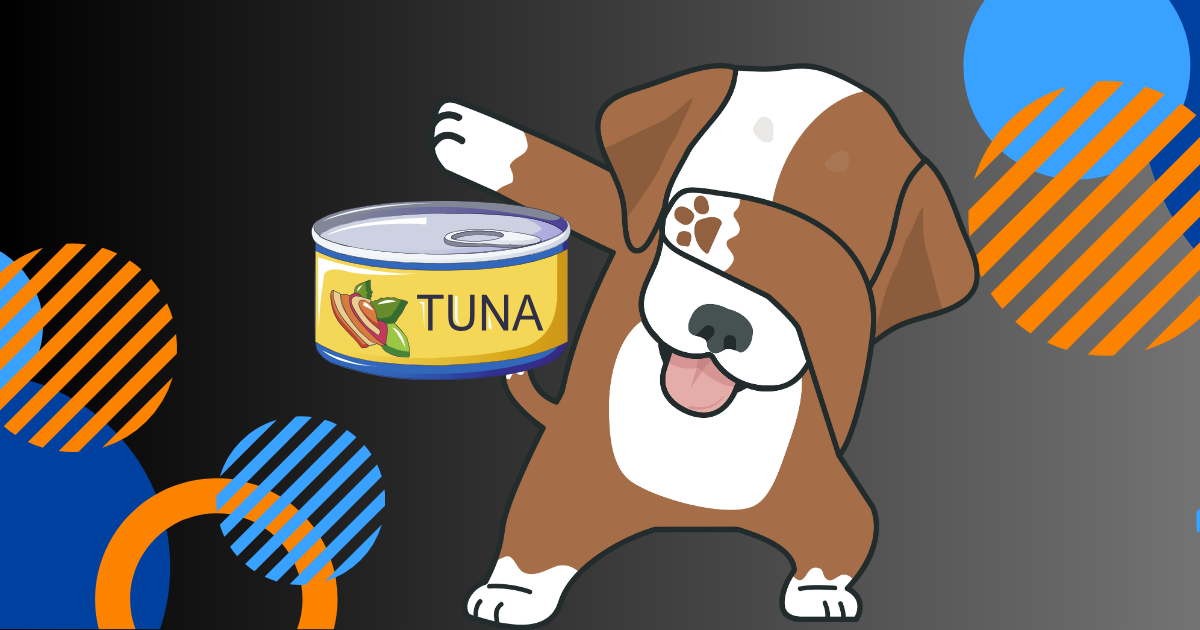When it comes to feeding your dog a healthy and balanced diet, it’s natural to wonder whether certain human foods are safe for them to consume. Tuna is a popular food for humans, often praised for its high protein content and omega-3 fatty acids, but can our canine companions enjoy this fish too? If you’re wondering, “Can dogs eat tuna?”, the answer isn’t as straightforward as it seems. In this article, we’ll explore 5 surprising facts about feeding tuna to dogs, whether it’s safe, and how to include it in your dog’s diet responsibly.
Can Dogs Eat Tuna? Breaking Down the Pros and Cons
Yes, dogs can eat tuna in moderation, but there are important considerations to keep in mind. While tuna can provide some nutritional benefits for dogs, such as high-quality protein and omega-3 fatty acids, it’s essential to be cautious about the type and amount of tuna you give to your pet. Tuna contains mercury, and feeding too much tuna can lead to mercury poisoning over time.
The Benefits of Tuna for Dogs
- High Protein: Tuna is an excellent source of lean protein, which is essential for maintaining strong muscles and tissues in dogs.
- Omega-3 Fatty Acids: These beneficial fats found in tuna help promote a healthy coat and support joint health. Omega-3s can also reduce inflammation and improve heart health in dogs.
- Vitamins and Minerals: Tuna contains essential nutrients like vitamin D, vitamin B12, and selenium, which contribute to overall health and well-being.
The Risks of Tuna for Dogs
Despite its nutritional benefits, there are risks associated with feeding tuna to dogs. Tuna is known to contain higher levels of mercury compared to other fish, and this can pose a health risk, especially if consumed frequently. Additionally, some canned tuna varieties are packed in oil, which can lead to digestive issues and weight gain in dogs if consumed regularly.
Is Canned Tuna Safe for Dogs?
The safety of canned tuna for dogs depends on the type of tuna and how it’s prepared. While it can be a convenient way to serve tuna, not all canned tuna is safe for dogs. Here’s what you need to know:
Canned Tuna in Water vs. Oil
Canned tuna in water is generally safer for dogs than tuna packed in oil. The oil can add unnecessary fats and calories to your dog’s diet and may cause gastrointestinal issues, such as diarrhea or vomiting. If you choose to give your dog canned tuna, make sure it’s packed in water and not oil, and that it’s free from added salt and seasonings.
Low-Sodium Tuna
Many canned tuna products contain added salt, which is not good for dogs. High sodium levels can lead to dehydration and contribute to health problems like high blood pressure and kidney issues in dogs. Always look for low-sodium or no-salt-added canned tuna when offering it to your dog.
How Much Tuna Can Dogs Eat Safely?
While tuna can be a healthy addition to your dog’s diet, it’s important to serve it in moderation. Because of the potential for mercury accumulation, tuna should be treated as an occasional treat rather than a regular part of your dog’s meals.
Recommended Portion Sizes
For most dogs, a small portion of tuna occasionally is safe. Here’s a general guideline for feeding tuna:
- Small dogs: 1-2 teaspoons of tuna once or twice a week.
- Medium dogs: 1-2 tablespoons of tuna once or twice a week.
- Large dogs: 2-3 tablespoons of tuna once or twice a week.
Keep in mind that these are approximate portion sizes and should not replace your dog’s regular meals. Tuna should be a supplement to a well-balanced diet, and it’s always best to consult your vet before introducing new foods into your dog’s routine.
Avoid Feeding Tuna Daily
Feeding tuna too frequently can increase the risk of mercury poisoning in dogs. To minimize this risk, avoid feeding tuna more than once or twice a week, and always serve it in small amounts. Additionally, consider rotating different types of fish, such as salmon or sardines, which are lower in mercury and safer for regular consumption.
Mercury Poisoning in Tuna: Is It a Risk for Dogs?
One of the main concerns with feeding tuna to dogs is the risk of mercury poisoning. Tuna, especially larger species like albacore and bluefin, tend to accumulate more mercury due to their long lifespan and position higher up in the food chain.
Symptoms of Mercury Poisoning in Dogs
Mercury poisoning can occur if a dog consumes too much tuna over time. The symptoms of mercury toxicity include:
- Tremors or shaking
- Lack of coordination
- Vomiting
- Diarrhea
- Abdominal pain
- Loss of appetite
- Lethargy
- Difficulty breathing
If you suspect your dog has ingested too much mercury or is showing any of these symptoms, contact your veterinarian immediately. Mercury poisoning is a serious condition that requires prompt medical attention.
How to Reduce the Risk
To reduce the risk of mercury poisoning, it’s important to limit your dog’s intake of tuna and choose other types of fish that are lower in mercury. Opt for skipjack tuna or light tuna, which tend to have lower mercury levels compared to albacore or bluefin tuna.
Tuna vs Other Fish: Which Is Better for Dogs?
While tuna can be fed to dogs in moderation, there are other types of fish that offer similar health benefits with less risk. If you want to give your dog fish on a more regular basis, consider these safer alternatives:
1. Salmon
Salmon is rich in omega-3 fatty acids and is generally lower in mercury than tuna. It’s a great option for promoting a healthy coat, reducing inflammation, and supporting joint health in dogs.
2. Sardines
Sardines are small, oily fish that are packed with omega-3s, protein, and essential vitamins. Because they are lower on the food chain, they contain much lower levels of mercury, making them a safer option for regular feeding.
3. Mackerel
Mackerel is another excellent source of omega-3 fatty acids and is relatively low in mercury. Like sardines, mackerel is a smaller fish, so it doesn’t accumulate as much mercury as larger species like tuna.
4. Cod
Cod is a lean, white fish that’s low in fat and easy to digest. It’s a good source of protein and a healthy alternative for dogs with sensitive stomachs.
By rotating different types of fish, you can provide your dog with a variety of nutrients while reducing the risks associated with mercury exposure from tuna.
What to Do If Your Dog Eats Too Much Tuna
If your dog accidentally consumes a large amount of tuna or you suspect they may have mercury poisoning, it’s essential to act quickly. Here’s what you should do:
1. Monitor for Symptoms
Keep a close eye on your dog for any signs of mercury poisoning, such as vomiting, tremors, or lethargy. If your dog shows any of these symptoms, contact your veterinarian immediately.
2. Provide Plenty of Water
Mercury poisoning can lead to dehydration, so make sure your dog has access to fresh water at all times. Drinking water can help flush out some of the toxins from your dog’s system.
3. Contact Your Vet
Even if your dog isn’t showing immediate symptoms, it’s a good idea to contact your vet for guidance. Your vet may recommend tests to check for elevated mercury levels and provide treatment if necessary.
Symptoms like vomiting, tremors, or lethargy could indicate a serious issue. For more information on toxic foods for pets, check out this comprehensive guide by the ASPCA on dangerous foods for dogs here.
Healthy Alternatives to Tuna for Dogs
If you’re looking for other healthy options to supplement your dog’s diet, there are plenty of fish alternatives and protein sources that are safer than tuna. Here are a few options to consider:
1. Chicken
Cooked chicken is a great source of lean protein and is safe for most dogs. It’s easy to digest and can be served as a treat or mixed into your dog’s regular meals.
2. Turkey
Turkey is another lean protein that’s safe for dogs and can be given as an alternative to tuna. Just make sure it’s cooked without any seasoning, especially garlic or onions, which are toxic to dogs.
3. Eggs
Eggs are a highly nutritious option for dogs, providing essential amino acids, vitamins, and minerals. They can be scrambled or boiled and served as a protein-rich treat.
4. Pumpkin
For a non-meat option, pumpkin is a nutritious and low-calorie food that’s safe for dogs. It’s rich in fiber and can help with digestive issues like constipation or diarrhea.
Want to know if other veggies are safe for your pup? Can Dogs Eat Bell Peppers? 7 Essential Facts Every Dog Owner Should Know is a must-read for keeping your dog’s diet healthy and balanced!
Conclusion: Can Dogs Eat Tuna? Proceed with Caution
So, can dogs eat tuna? Yes, but it should be done with caution and moderation. While tuna offers some great nutritional benefits, including high-quality protein and omega-3 fatty acids, it also carries the risk of mercury poisoning. To keep your dog safe, limit their tuna intake to small portions and avoid feeding it too frequently. When choosing canned tuna, opt for tuna packed in water with no added salt. Always consult your vet before introducing new foods into your dog’s diet, especially when it comes to fish like tuna that carry potential risks. For a safer option, consider other fish like salmon, sardines, or mackerel, which provide similar benefits without the high mercury levels.
FAQs About Dogs and Tuna
- Can dogs eat tuna?
Yes, dogs can eat tuna in small amounts, but it should be served occasionally to avoid the risk of mercury poisoning. - Is canned tuna safe for dogs?
Canned tuna in water is safer than tuna in oil, but it should still be fed in moderation due to its mercury content. - How much tuna can dogs eat?
Small dogs can have 1-2 teaspoons, medium dogs 1-2 tablespoons, and large dogs 2-3 tablespoons of tuna once or twice a week. - Is tuna toxic to dogs?
Tuna can become toxic if consumed in large quantities over time due to the risk of mercury accumulation. - Can dogs eat tuna every day?
No, feeding tuna every day is not recommended due to the risk of mercury poisoning. Tuna should only be an occasional treat. - What are the symptoms of mercury poisoning in dogs?
Symptoms include vomiting, diarrhea, tremors, lack of coordination, lethargy, and difficulty breathing. - Is tuna good for dogs?
Tuna is a good source of protein and omega-3 fatty acids, but it should be served sparingly to avoid health risks. - Can dogs eat raw tuna?
It’s best to avoid feeding raw tuna to dogs due to the potential for parasites and high mercury levels. - What types of fish are safer than tuna for dogs?
Salmon, sardines, mackerel, and cod are safer fish options with lower mercury levels. - Can tuna help with a dog’s coat?
Yes, the omega-3 fatty acids in tuna can promote a healthy coat, but it’s important to limit tuna intake due to mercury concerns.




